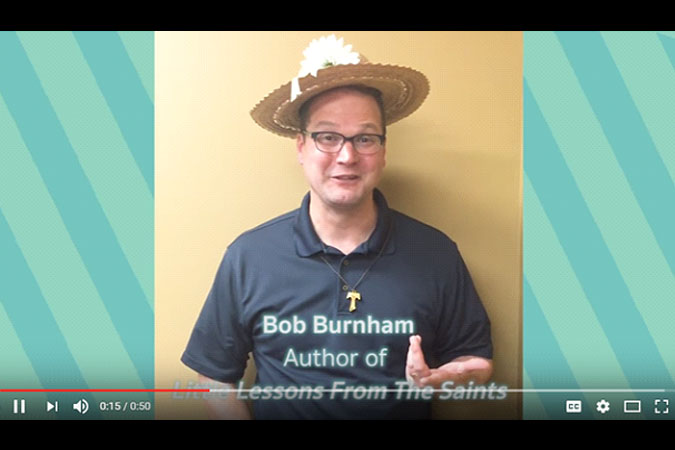
A few months ago, a friend of mine told me she was going to use one of the videos I filmed for my book Little Lessons from the Saints at her next RCIA session.
“Really?”
“Yep. I’m leading a lesson on the communion of saints, so it’s perfect. Besides, I think they would get a kick out of seeing you on video.”
“Either that or a good laugh.”
“Probably both,” she said.
A few days after her lesson, we met over a cup of coffee and I asked her how it went. As I picked her brain, I became curious: how might these videos be a useful resource for other catechists when teaching about the saints? She offered some helpful advice for how they might fit into a lesson:
- Show only one video. “We got carried away,” my friend told me, “and kept on watching one after the other.” The videos are short—the longest is only about 90 seconds long. A catechist might be tempted to watch a bunch of them to fill up the time. Instead, select a video that is most relevant to your lesson, and show it to your class.
- Have a discussion. She continued, saying, “I wish we spent some time talking about how they might apply the lessons you shared.” If you show too many videos, you won’t leave enough time for conversation. The value in these videos is that they provide the opportunity to start a conversation. Talk about how the young people can apply the lesson from the video. You might also want to discuss the challenges they might face in applying that lesson.
- Provide some background. “The people in class had some questions about the saints,” she explained. “I should have been prepared with a little biographical information about them.” That’s an excellent point. I don’t provide much in the way of facts about the saints’ lives in these videos. Rather, I simply share a lesson that I learned from them. You might benefit from reading a little bit about the saint whose video you are going to show. Introduce the video by sharing that information with the young people in your class.
- Be strategic. “In hindsight,” my friend concluded, “I probably would have shown the videos at the end of the session.” Think about how the video would best fit into your lesson plan. Would it be a good warm-up activity or a conversation starter? Would it be a good way to end the class? Would it best serve as a transition activity within your lesson?
The little lessons I offer in the videos are just that: they are short and to the point. My hope is that viewers of any will be inspired to learn more about the saints in the videos, and in so doing, learn to see the saint in themselves.
At the very least, they might give you and your class a good laugh. After all, St. Philip Neri reminds us that “servant[s] of God ought always to be in good spirits.”
If you decide to use the videos in your classroom, let us know how it goes. And for more on the effective use of audiovisual resources in faith formation, read Joe Paprocki’s post here.





Video was Good for an ending lesson,keeping the theme of cheer and happiness.
You said it was short but I didn’t imagine that short. This could be used as an opening window to a discussion on the saints. What is a saint. Why are they important to our church and faith? What does communion of saints in the creed mean? Let’s find out more about this saint described here. What message does he send to you? Yes, a good building block for a class lesson. I would use it!